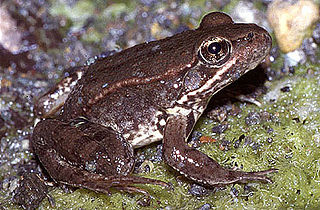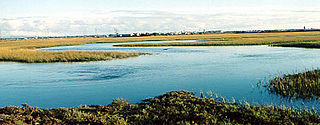The Weyerhaeuser Company is an American timberland company which owns nearly 12,400,000 acres of timberlands in the U.S., and manages an additional 14,000,000 acres of timberlands under long-term licenses in Canada. The company has manufactured wood products for over a century. It operates as a real estate investment trust (REIT).

The Endangered Species Act of 1973 is the primary law in the United States for protecting and conserving imperiled species. Designed to protect critically imperiled species from extinction as a "consequence of economic growth and development untempered by adequate concern and conservation", the ESA was signed into law by President Richard Nixon on December 28, 1973. The Supreme Court of the United States described it as "the most comprehensive legislation for the preservation of endangered species enacted by any nation". The purposes of the ESA are two-fold: to prevent extinction and to recover species to the point where the law's protections are not needed. It therefore "protect[s] species and the ecosystems upon which they depend" through different mechanisms. For example, section 4 requires the agencies overseeing the Act to designate imperiled species as threatened or endangered. Section 9 prohibits unlawful ‘take,’ of such species, which means to "harass, harm, hunt..." Section 7 directs federal agencies to use their authorities to help conserve listed species. The Act also serves as the enacting legislation to carry out the provisions outlined in The Convention on International Trade in Endangered Species of Wild Fauna and Flora (CITES). The Supreme Court found that "the plain intent of Congress in enacting" the ESA "was to halt and reverse the trend toward species extinction, whatever the cost." The Act is administered by two federal agencies, the United States Fish and Wildlife Service (FWS) and the National Marine Fisheries Service (NMFS). FWS and NMFS have been delegated by the Act with the authority to promulgate any rules and guidelines within the Code of Federal Regulations (CFR) to implement its provisions.
Tennessee Valley Authority v. Hiram Hill et al., or TVA v. Hill, 437 U.S. 153 (1978), was a United States Supreme Court case and the Court's first interpretation of the Endangered Species Act of 1973. After the discovery of the snail darter fish in the Little Tennessee River in August 1973, a lawsuit was filed alleging that the Tennessee Valley Authority (TVA)'s Tellico Dam construction was in violation of the Endangered Species Act. Plaintiffs argued dam construction would destroy critical habitat and endanger the population of snail darters. It was decided by a 6-3 vote, in which the U.S. Supreme Court ruled in favor of Hill, et al. and granted an injunction stating that there would be conflict between Tellico Dam operation and the explicit provisions of Section 7 of the Endangered Species Act.
Ironwood Ridge High School is a public high school located in Oro Valley, Arizona. Ironwood Ridge is one of three high schools in the Amphitheater Public School District and serves grades 9-12. The school mascot is the nighthawk, and the school colors are navy blue and silver. Ironwood Ridge opened in 2001 and has a student enrollment of 1,942. The school's name originates from the abundance of desert ironwood trees in the area and the school's location in the rugged foothills of the Tortolita Mountains.

The California red-legged frog is a species of frog found in California (USA) and northern Baja California (Mexico). It was formerly considered a subspecies of the northern red-legged frog. The frog is an IUCN near-threatened species as of 2021, has a NatureServe conservation status of Imperiled as of 2015, and is a federally listed threatened species of the United States that is protected by law.

The Center for Biological Diversity is a nonprofit membership organization known for its work protecting endangered species through legal action, scientific petitions, creative media and grassroots activism. It was founded in 1989 by Kieran Suckling, Peter Galvin, Todd Schulke and Robin Silver. The center is based in Tucson, Arizona, with its headquarters in the historic Owls club building, and has offices and staff in New Mexico, Nevada, California, Oregon, Illinois, Minnesota, Alaska, Vermont, Florida and Washington, D.C.

The Seal Beach National Wildlife Refuge is a wildlife refuge encompassing 965 acres (3.91 km2) located in the California coastal community of Seal Beach. Although it is located in Orange County it is included as part of the San Diego National Wildlife Refuge Complex. It was established in 1972.
Julie A. MacDonald is a former deputy assistant secretary for Fish and Wildlife and Parks at the United States Department of the Interior. MacDonald was appointed by former Secretary of the Interior Gale Norton on 3 May 2004 and resigned on 1 May 2007 after an internal investigation found that she had "injected herself personally and profoundly in a number of Endangered Species Act decisions", a violation of the Code of Federal Regulations under Use of Nonpublic Information and Basic Obligation of Public Service, Appearance of Preferential Treatment.

The Mississippi gopher frog, also known commonly as the dark gopher frog, the dusky gopher frog, and the St. Tammany gopher frog, is a critically endangered species of frog in the family Ranidae. The species is endemic to the southern United States. Its natural habitats are temperate coastal forests and intermittent freshwater marshes. This secretive frog is on average 3 in (8 cm) long, with a dark brown or black dorsal surface covered in warts. It is a federally listed endangered species of the United States.

Fish stocking is the practice of releasing fish that are artificially raised in a hatchery into a natural body of water, in order to supplement existing wild populations or to create a new population where previously none exists. Stocking may be done for the benefit of commercial, recreational or tribal heritage fishing, but may also be done for ecological conservation to restore or increase the population of threatened/endangered fish species that is pressured by prior overfishing, habitat destruction and/or competition from invasive species.
The Pacific Legal Foundation (PLF) is an American nonprofit public interest legal organization established for the purpose of defending and promoting individual and economic freedom. PLF attorneys provide pro bono legal representation, file amicus curiae briefs, and hold administrative proceedings with the stated goal of supporting property rights, equality before the law, freedom of speech and association, economic liberty, and the separation of powers. The organization is the first and oldest libertarian public interest law firm, having been founded in 1973.

Eleutherodactylus juanariveroi, or the Puerto Rican wetland frog, is an endangered species of coqui, a frog species, endemic to Puerto Rico. It was discovered in 2005 by Neftalí Rios, and was named after Puerto Rican herpetologist Juan A. Rivero, in honor of his contributions to Puerto Rican herpetology.
National Assn. of Home Builders v. Defenders of Wildlife, 551 U.S. 644 (2007), was a United States Supreme Court case about federal jurisdiction over anti-pollution statutes. Justice Samuel Alito wrote the opinion of the Court, holding that the Endangered Species Act did not require the Environmental Protection Agency to apply additional criteria when evaluating a transfer of pollution control jurisdiction under the Clean Water Act. Justices John Paul Stevens and Stephen Breyer wrote dissenting opinions.

The Sonny Bono Salton Sea National Wildlife Refuge is located in the Imperial Valley of California, 40 miles (64 km) north of the Mexican border. Situated at the southern end of the Salton Sea, the refuge protects one of the most important nesting sites and stopovers along the Pacific Flyway. Despite its location in the Colorado Desert, a subdivision of the larger Sonoran Desert, the refuge contains marine, freshwater, wetland, and agricultural habitats which provide sanctuary for hundreds of birds and wetland species, including several that have been listed as endangered or sensitive by the U.S. Fish and Wildlife Service.
Babbitt, Secretary of the Interior v. Sweet Home Chapter of Communities for a Great Oregon, 515 U.S. 687 (1995), is a US Supreme Court case, decided by a 6–3 vote, in which the plaintiffs challenged the Interior Department's interpretation of the word "harm" in the Endangered Species Act (ESA).

Rio Grande Silvery Minnow v. Bureau of Reclamation, called Rio Grande Silvery Minnow v. Keys in its earlier phases, was a case launched in 1999 by a group of environmentalists against the United States Bureau of Reclamation and the United States Army Corps of Engineers alleging violations of the Endangered Species Act and the National Environmental Policy Act. The case resulted in significant changes to water and river management in the Middle Rio Grande Basin of New Mexico in an effort to reverse the damage that had been done to the habitat of two endangered species.

Sierra Club v. Babbitt, 15 F. Supp. 2d 1274, is a United States District Court for the Southern District of Alabama case in which the Sierra Club and several other environmental organizations and private citizens challenged the United States Fish and Wildlife Service (FWS). Plaintiffs filed action seeking declaratory injunctive relief regarding two incidental take permits (ITPs) issued by the FWS for the construction of two isolated high-density housing complexes in habitat of the endangered Alabama beach mouse. The District Court ruled that the FWS must reconsider its decision to allow high-density development on the Alabama coastline that might harm the endangered Alabama beach mouse. The District Court found that the FWS violated both the Endangered Species Act (ESA) and the National Environmental Policy Act (NEPA) by permitting construction on the dwindling beach mouse habitat.
In 1970 California became one of the first states in the U.S. to implement an act that conserves and protects endangered species and their environments. The California Endangered Species Act (CESA) declares that "all native species of fishes, amphibians, reptiles, birds, mammals, and plants, and their habitats, threatened with extinction and those experiencing a significant decline which, if not halted, would lead to a threatened or endangered designation, will be protected or preserved."

The Threatened Species Conservation Act 1995 (TSC Act) was enacted by the Parliament of New South Wales in 1995 to protect threatened species, populations and ecological communities in NSW. In 2016 it was replaced by the Biodiversity Conservation Act 2016. These acts form the basis and the mechanisms in NSW by which species, populations and ecological communities are declared endangered, vulnerable or critically endangered, and under which people and corporations are prosecuted for destruction of habitat sheltering such species, populations or communities.
United States Fish and Wildlife Service v. Sierra Club, Inc., 592 U.S. ___ (2021), was a Supreme Court of the United States case involving whether the use of a Freedom of Information Act (FOIA) request can be used to access documents from a U.S. agency that are protected under the deliberative process privilege exemption, in this specific case, draft biological opinions made and reviewed by the United States Fish and Wildlife Service (FWS) and the National Marine Fisheries Service (NMFS) prior to a final rulemaking decision by the Environmental Protection Agency (EPA) related to impacts on endangered aquatic species, requested by the Sierra Club. The Court ruled in a 7–2 decision in 2021 that the government does not have to disclose "draft biological opinions" involving potential threats to endangered species, even though the drafts reflect an agency's final proposal. The ruling limits environmental groups' ability to obtain government documents using the FOIA.












